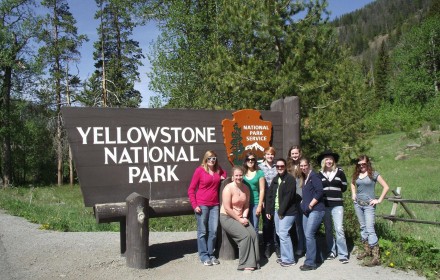Study-Travel in the American West

Amberlyn Smith ’14 never expected that her Converse education would involve vaccinating cattle. But that’s exactly what she found herself doing in May 2012 when she was part of a group of students who traveled to Wyoming to study the history of the American West with Dr. Edward Woodfin, associate professor of history.
“I did everything the ranch hands did including castrating, vaccinating, de-worming…”
Amberlyn remembers the cattle round-up as the highlight of the trip. “The group woke up at 4:00am. We watched as the ranch hands rounded up hundreds of cattle. The calves were put in one big pen and then we Converse girls began helping. I actually dreaded this part of the trip when I first found out about it, and was very distant until I watched how fast the ranch hands did everything! I did everything the ranch hands did including castrating, vaccinating, de-worming, and shooing the other cattle away.”
For Amberlyn’s classmate, Stefanie Carter ’13, the high point was a visit to Yellowstone National Park. She explained, “The landscapes and wildlife at Yellowstone were mind-blowing—the rolling hills and being able to see further in the distance than I even thought possible.”
A Typical Day at the Ranch
Stefanie recalled, “On a typical day, my cabin-mates and I would wake up and step outside to see deer in the back yard, the ranch hands running the horses to the stables in the pasture, and the mountains coming out of the mist in the distance behind the rolling hills. We would meet fairly early and head to the first stop of the day, whether a museum, historic house, battlefield, or historic site on a reservation. All along the way we would occasionally stop to see the sights, like the buffalo in Yellowstone, or an old run-down settler’s house. We usually stopped somewhere for a bagged lunch. One of the days in Yellowstone, we stopped at a picnic area next to a stream, and it actually started snowing. After the day’s festivities, we would head back to the ranch or the hotel in Yellowstone and often eat dinner together and discuss the day. Bedtime came quickly, since everyone was mainly exhausted – but happy.”
Alumna Rancher Supports Hands-On Learning
It all started with an invitation from Marion Rivers Cato ‘65 and her husband, Wayland. The Catos invited Dr. Woodfin to bring a group of students to study at their Wyoming ranch, and they provided housing for the entire gang in the ranch bunkhouses. The ranch served as headquarters for the Converse students as they traveled around the American West.
“The historic sites and scenery made the history come to life like no pictures or books could have.”
In addition to asking the students to read a number of memoirs on the history of the American West, Dr. Woodfin planned a full itinerary of visits to important sites in western history. According to Stefanie, study-travel is a powerful way to learn. She said, “The combination of readings, class-time, museums, and actual historic sites and scenery came together to make the history really come to life like no pictures or books could have done.”
Study-Travel Advice
Amberlyn and Stefanie both believe study-travel is a valuable part of the college experience. Stefanie’s advice to students, “If you can afford to go, go. Especially if you haven’t traveled much before.” Amberlyn said, “For a student interested in study-travel, I would advise them to pick a trip they think that they would enjoy. Also, I think it is important to pick a trip where the students would be comfortable with the professor. I am very comfortable with Dr. Woodfin, and that helped me throughout the trip because there was not any awkwardness. I think the most important thing that a student should think about when considering to study-travel is to go with their gut and take chances!”